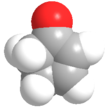| Revision as of 15:11, 27 November 2023 editSmokefoot (talk | contribs)Autopatrolled, Extended confirmed users, Pending changes reviewers, Rollbackers74,617 edits rephrase lede← Previous edit | Latest revision as of 17:43, 11 September 2024 edit undoBernanke's Crossbow (talk | contribs)Extended confirmed users7,875 edits →Synthesis: link | ||
| Line 46: | Line 46: | ||
| The acid-catalyzed dehydration of cyclopentanediols affords cyclopentenone.<ref>{{cite journal|title=2-Cyclopentenone |author=Charles H. DePuy |author2=K. L. Eilers|journal=Org. Synth.|year=1962|volume=42|page=38|doi=10.15227/orgsyn.042.0038}}</ref> | The acid-catalyzed dehydration of cyclopentanediols affords cyclopentenone.<ref>{{cite journal|title=2-Cyclopentenone |author=Charles H. DePuy |author2=K. L. Eilers|journal=Org. Synth.|year=1962|volume=42|page=38|doi=10.15227/orgsyn.042.0038}}</ref> | ||
| As a functional group, the synthesis of 2-cyclopentenones is accomplished in a variety of other ways, including the ] from divinyl |
As a functional group, the synthesis of 2-cyclopentenones is accomplished in a variety of other ways, including the ] from ]s, ] from ]s, ] from the corresponding ]s, ] of the corresponding cyclic ]s, and the ] from ]s, ]s, and ].<ref name="prep3">{{cite web|last1=Müller|first1=Reto|title=Synthesis of cyclopentenones|url=https://www.organic-chemistry.org/synthesis/C1C/cyclic/enones/cyclopentenones.shtm|website=Organic Chemistry Portal|access-date=3 March 2015}}</ref> | ||
| ==Reactions== | ==Reactions== | ||
Latest revision as of 17:43, 11 September 2024
| |||
| Names | |||
|---|---|---|---|
| Preferred IUPAC name Cyclopent-2-en-1-one | |||
| Identifiers | |||
| CAS Number | |||
| 3D model (JSmol) | |||
| ChEBI | |||
| ChEMBL | |||
| ChemSpider | |||
| ECHA InfoCard | 100.012.012 | ||
| PubChem CID | |||
| UNII | |||
| CompTox Dashboard (EPA) | |||
InChI
| |||
SMILES
| |||
| Properties | |||
| Chemical formula | C5H6O | ||
| Molar mass | 82.102 g·mol | ||
| Density | 0.98 g·mL | ||
| Boiling point | 150 °C (302 °F; 423 K) | ||
| Solubility in water | almost insoluble in water | ||
| Hazards | |||
| Occupational safety and health (OHS/OSH): | |||
| Main hazards | Harmful | ||
| Flash point | 42 °C (108 °F; 315 K) | ||
| Except where otherwise noted, data are given for materials in their standard state (at 25 °C , 100 kPa).
| |||
2-Cyclopentenone is the organic compound with the chemical formula (CH2)2(CH)2CO. 2-Cyclopentenone contains two functional groups, a ketone and an alkene. It is a colorless liquid. Its isomer, 3-cyclopentenone is less commonly encountered.
The term cyclopentenone may also refer to a structural motif wherein the cyclopentenone moiety is a subunit of a larger molecule. Cyclopentenones are found in a large number of natural products, including jasmone, the aflatoxins, and several prostaglandins.
Synthesis
2-Cyclopentenones can be synthesized in a number of ways. One of the routes involves elimination of α-bromo-cyclopentanone using lithium carbonate and Claisen condensation-decarboxylation-isomerization cascades of unsaturated diesters as shown below.

The acid-catalyzed dehydration of cyclopentanediols affords cyclopentenone.
As a functional group, the synthesis of 2-cyclopentenones is accomplished in a variety of other ways, including the Nazarov cyclization reaction from divinyl ketones, Saegusa–Ito oxidation from cyclopentanones, ring-closing metathesis from the corresponding dienes, oxidation of the corresponding cyclic allylic alcohols, and the Pauson–Khand reaction from alkenes, alkynes, and carbon monoxide.
Reactions
As an enone, 2-cyclopentenone undergoes the typical reactions of α-β unsaturated ketones, including nucleophilic conjugate addition, the Baylis–Hillman reaction, and the Michael reaction. Cyclopentenone also functions as an excellent dienophile in the Diels–Alder reaction, reacting with a wide variety of dienes. In one example, a Danishefsky-type diene is reacted with a cyclopentenone to yield a fused tricyclic system en route to the synthesis of coriolin.

Occurrence
It has been isolated from pressure-cooked pork liver by simultaneous steam distillation and continuous solvent extraction.
Related compounds
- cyclopropenone
- cyclobutenone
- cyclohexenone
- cycloheptenone
References
- Simeonov, Svilen P.; Nunes, João P. M.; Guerra, Krassimira; Kurteva, Vanya B.; Afonso, Carlos A. M. (2016-05-25). "Synthesis of Chiral Cyclopentenones". Chemical Reviews. 116 (10): 5744–5893. doi:10.1021/cr500504w. ISSN 0009-2665. PMID 27101336.
- US EP1418166, Daisuke, Fukushima & Norihiko, Hirata, "Process for producing 2-bromocyclopentanone", published 2004-05-12
- US EP1422212, Liang, Shelue; Haunert, Andrea & Huber-Dirr, Sylvia et al., "Process for preparing cyclopentenone", published 2004-11-25
- Charles H. DePuy; K. L. Eilers (1962). "2-Cyclopentenone". Org. Synth. 42: 38. doi:10.15227/orgsyn.042.0038.
- Müller, Reto. "Synthesis of cyclopentenones". Organic Chemistry Portal. Retrieved 3 March 2015.
- Danishefsky, Samuel; Zamboni, Robert; Kahn, Michael; Etheredge, Sarah Jane (March 1980). "Total synthesis of dl-coriolin". Journal of the American Chemical Society. 102 (6): 2097–2098. doi:10.1021/ja00526a061.
- Mussinan, Cynthia J.; Walradt, John P. (May 1974). "Volatile constituents of pressure cooked pork liver". Journal of Agricultural and Food Chemistry. 22 (5): 827–831. doi:10.1021/jf60195a002.
- Simeonov, Svilen P.; Nunes, João P. M.; Guerra, Krassimira; Kurteva, Vanya B.; Afonso, Carlos A. M. (2016). "Synthesis of Chiral Cyclopentenones". Chemical Reviews. 116 (10): 5744–5893. doi:10.1021/cr500504w. PMID 27101336.
- A. G. Ross, X. Li, S. J. Danishefsky (2012). "Preparation of Cyclobutenone". Organic Syntheses. 89: 491. doi:10.15227/orgsyn.089.0491.
{{cite journal}}: CS1 maint: multiple names: authors list (link) - Y. Ito, S. Fujii, M. Nakatuska, F. Kawamoto,T. Saegusa (1979). "One-Carbon Ring Expansion of Cycloalkanones to Conjugated Cycloalkenones: 2-Cyclohepten-1-One". Organic Syntheses. 59: 113. doi:10.15227/orgsyn.059.0113.
{{cite journal}}: CS1 maint: multiple names: authors list (link)

